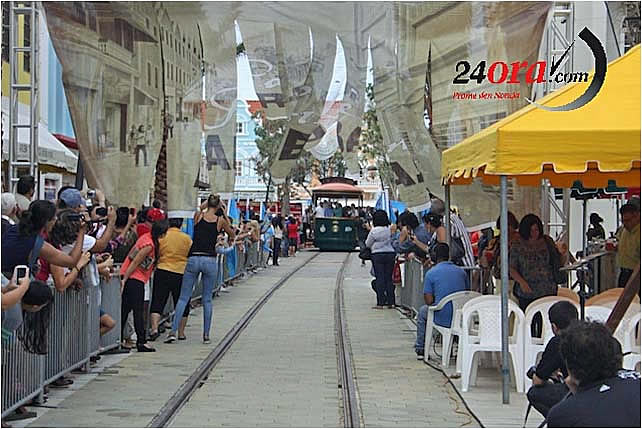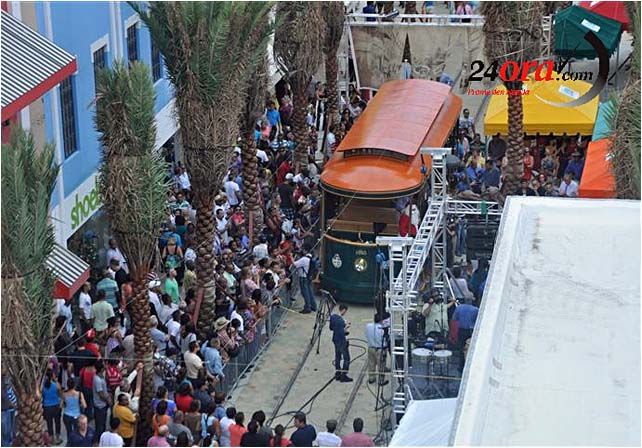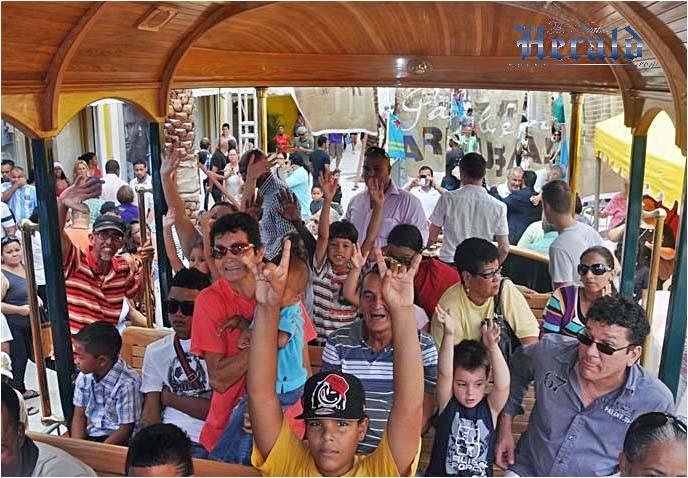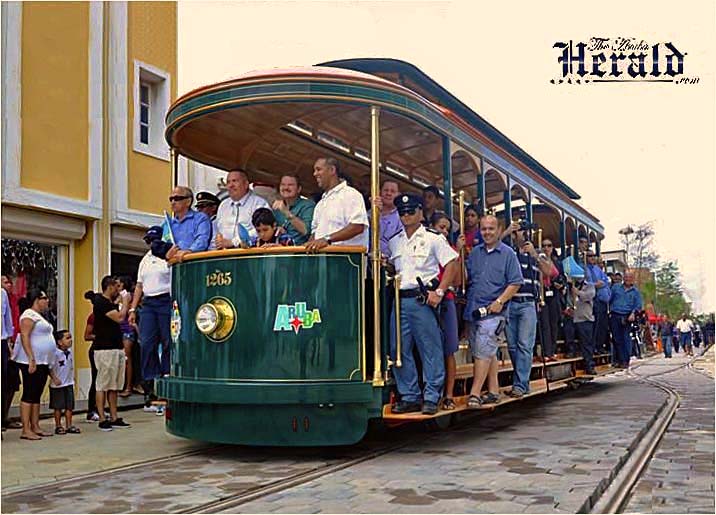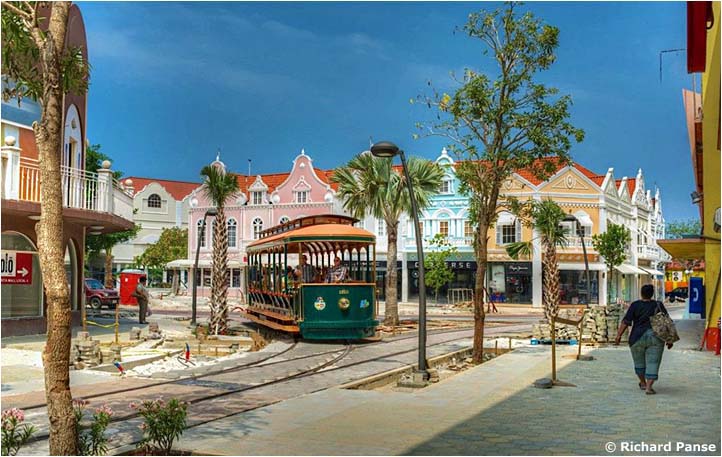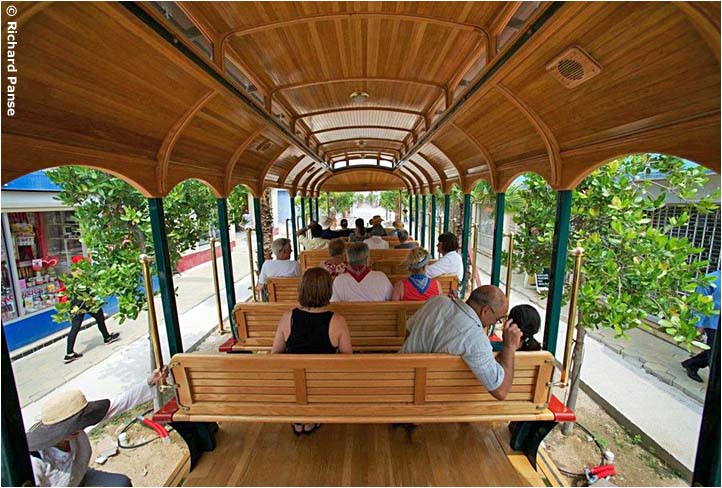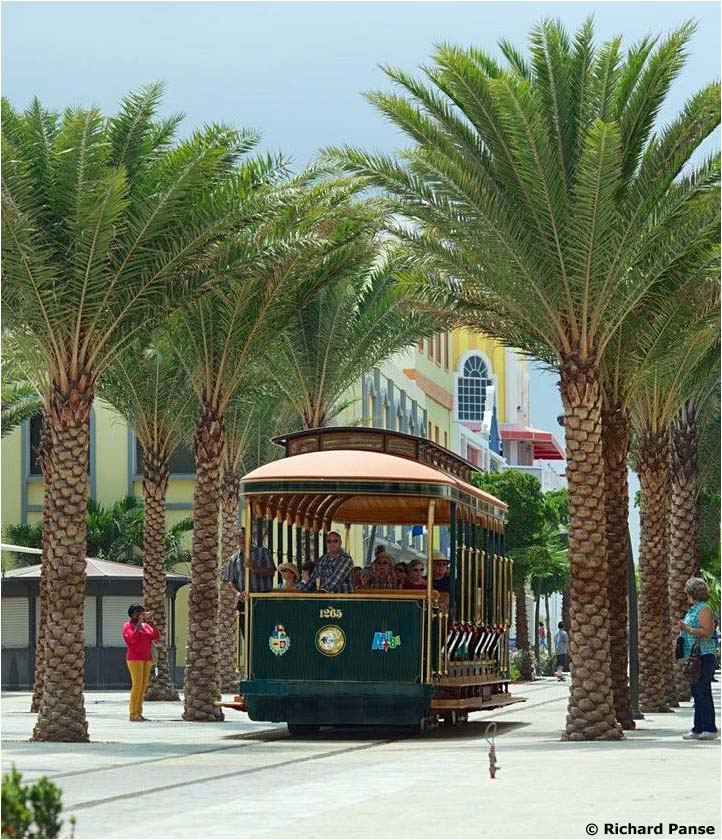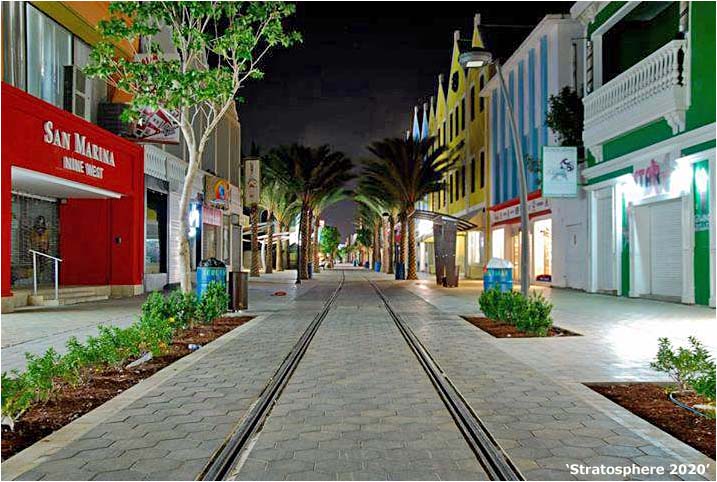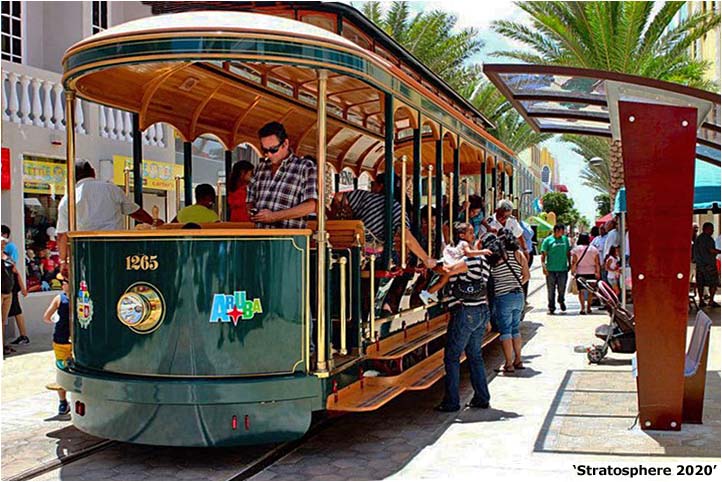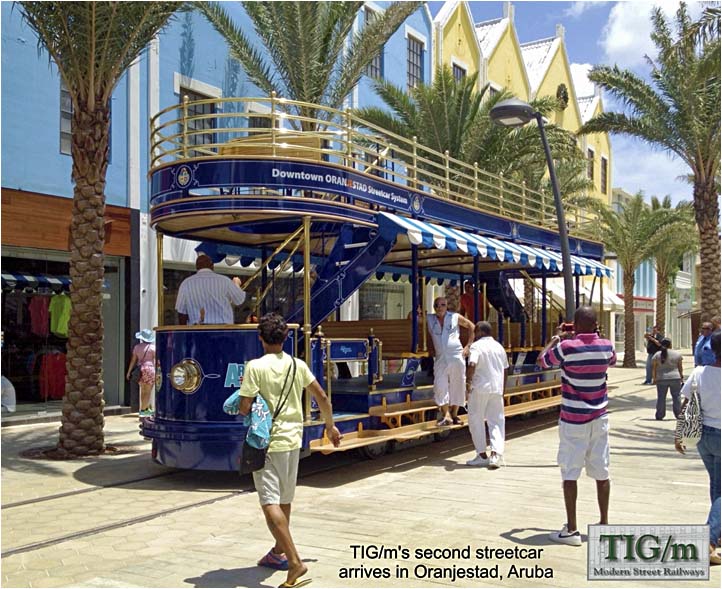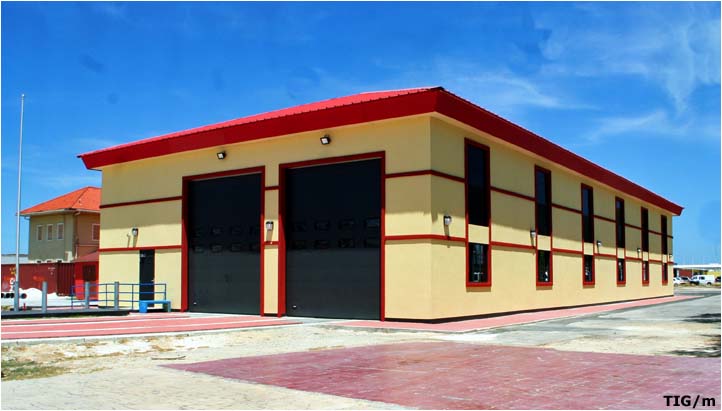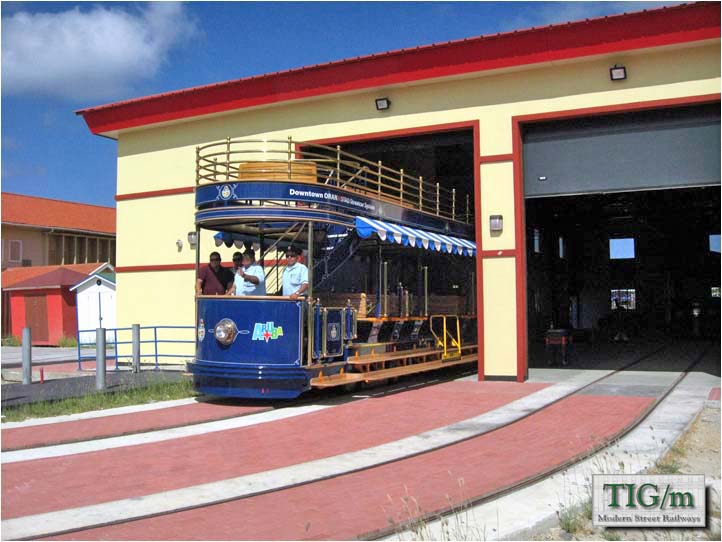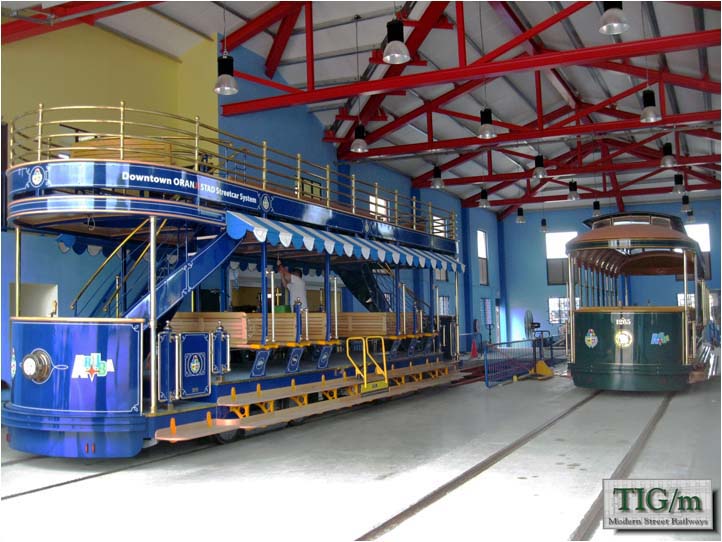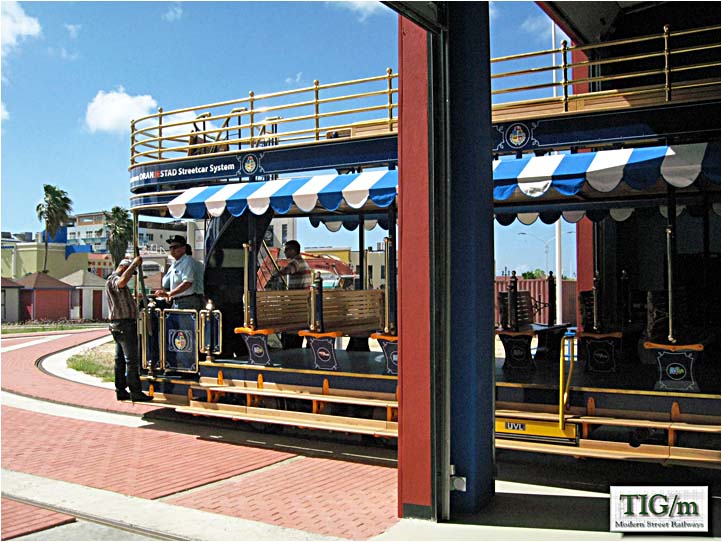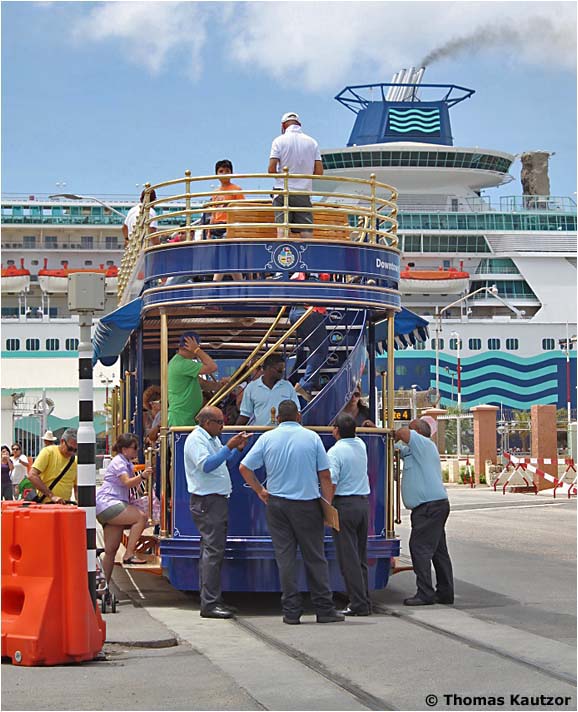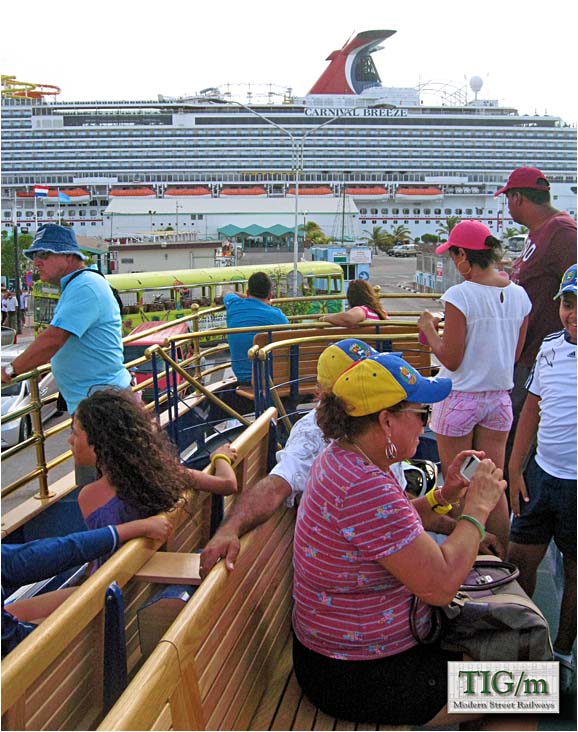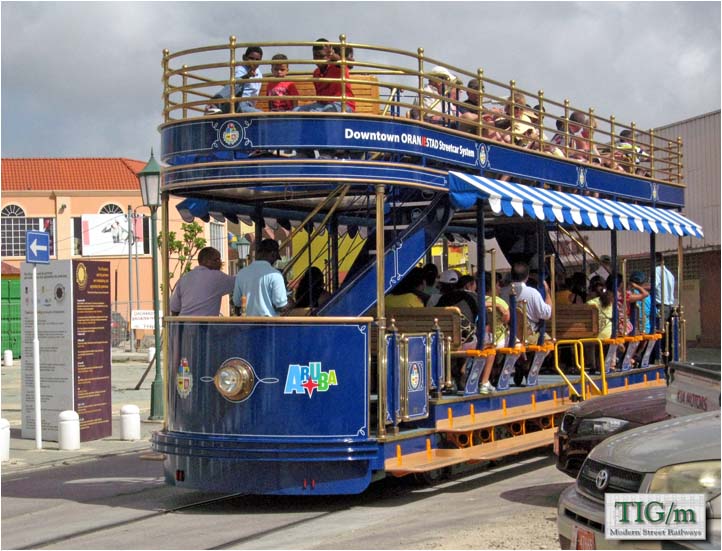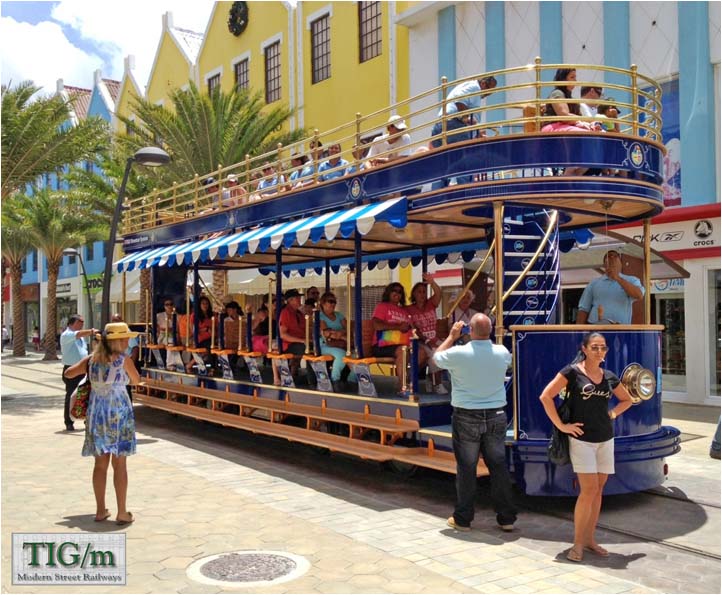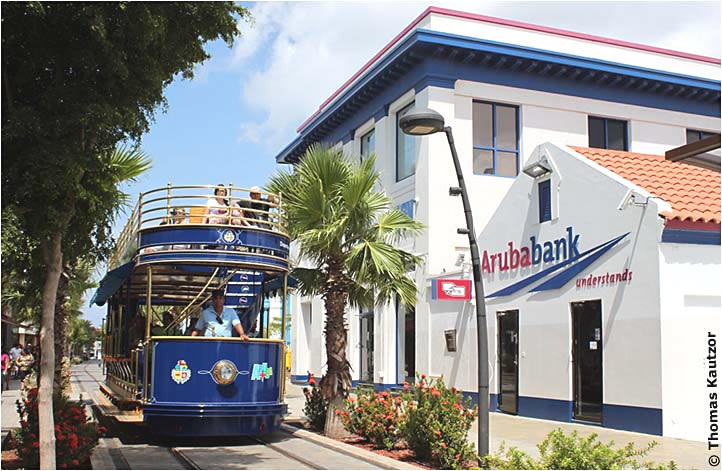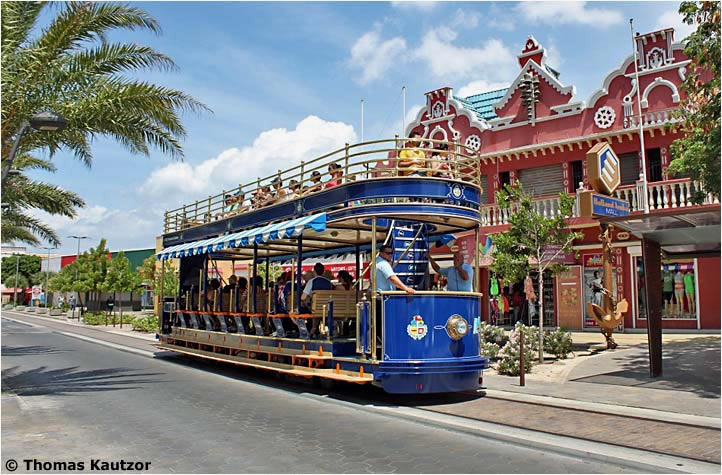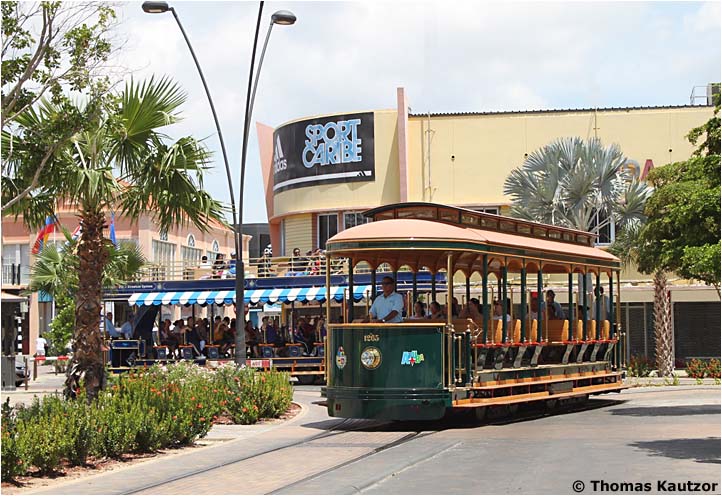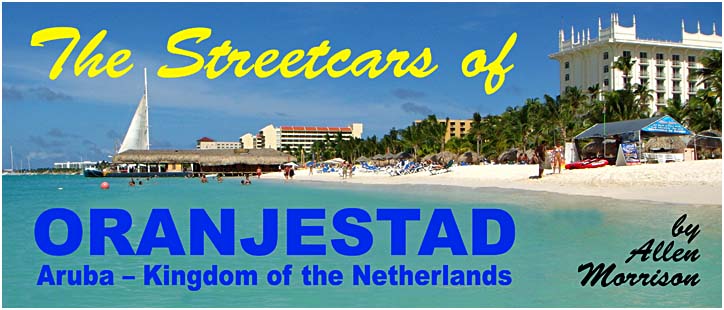 [Palm Beach, Aruba. Photograph by 'Atilin', Wikipedia] –––––––––––––– Only 17 miles (27 km) from the coast of Venezuela, Aruba is the smallest of the "ABC islands" (Aruba, Bonaire, Curaçao) of the former Dutch Antilles [see area map]. Since 1986, along with Curaçao and Sint Maarten in the eastern Caribbean, Aruba has been one of four 'countries' that comprise the Kingdom of the Netherlands. Population in 2010 was 101,484. A third of its residents live in its capital city, Oranjestad. The island's official languages are Dutch and Papiamento, but English is spoken at hotels and shops. Three-fourths of Aruba's GNP today comes from tourism. Unlike Curaçao, Aruba never before had a railway in a street. But it had several industrial lines scattered about the island. Its first railway opened about 1850 at a gold mine near Balashi. A phosphate mine laid a railway at the southern tip of the island in the 1880s. Lago Oil opened the first section of a rail network around its refineries at Sint Nicolaas in 1928 and, about the same time, Eagle Oil established a refinery and rail lines near Oranjestad. Lago was one of the world's largest producers of aircraft fuel and both the Lago and Eagle installations were torpedoed by German submarines in 1942. One of the Eagle Railway lines ran until 1960 to a wharf near where the streetcars run today [see city map]. As its petroleum industry declined, Aruba concentrated on tourism. Its white sand beaches were extended, the airport and dock facilities were enlarged, and a battery-powered streetcar line was built from the cruise ship terminal down the capital's main street, which was converted to a pedestrian mall. The line was inspired by the popular battery-powered streetcar operation at The Grove in Los Angeles, U.S.A. In 2010 Aruba's Minister of Infrastructure Benny Sevinger visited the California factory of TIG/m, the company that had designed the Los Angeles car, and before long TIG/m was constructing two streetcars, a single- and a double-decker, for Aruba. In 2012 Prime Minister Mike Eman signed an agreement with Sir Richard Branson, founder of the Virgin enterprises, the Carbon War Room and other organizations, to make Aruba the world's first 100% 'green' economy by 2020. Aruba's streetcars are powered by batteries augmented by hydrogen fuel cells, which in turn are powered by the island's year-round trade winds. Arubans claim that they are the first in the world to use hydrail technology in regular passenger service. The vehicles are bidirectional and use PCC type B2 trucks that were manufactured in the last century by Clark Equipment Co. for streetcars that ran in Boston and Shaker Heights, Ohio. TIG/m re-machined the wheels to conform with the Ri59 rail laid in Oranjestad. The single-deck car arrived in Aruba on 15 December 2012 and the line was formally inaugurated the following 22 December – the Saturday before Christmas. The following three photographs of the inauguration were taken by the staff of the online newspaper 24ora.com:
The man waving the Aruban flag in the last photo is Aruban Prime Minister Mike Eman. The photograph below was taken by the Aruba Herald newspaper:
Another Aruba Herald photograph taken on 22 December 2012:
The line was formally 'inaugurated' in December, but regular everyday operation did not begin until 19 February 2013. Landscaping, traffic signaling and final touches on the pedestrian mall took several months. The photograph below, which shows one of the junctions on Schelp Straat, was taken by American visitor Richard Panse on 13 May [see map]. Note the lack of overhead wires:
A nice interior view by Richard Panse, taken as the car moved along Caya Betico Croes, the city's main street [see map]. Who would not enjoy a ride on this beautiful, friendly, naturally air-conditioned vehicle? The little windows along the roofline – the clerestory – provide additional ventilation:
Caya Betico Croes is now a quiet, bucolic, pollution-free pedestrian mall. Only streetcars and people are allowed [see map] [Richard Panse]:
The main street at night [see map]. Track gauge is standard 56 1/2 in = 1435 mm. The line is approximately 3/4 mi (1.2 km) long ['Stratosphere 2020']:
The following photograph was taken in June 2013. Notice the elegant construction of the vehicle and the reflection of the track on its front panel ['Stratosphere 2020']:
Oranjestad's second, double-deck streetcar arrived at port on 4 June and was photographed on Caya Betico Croes on 13 June [see map] [TIG/m]:
The magnificent carbarn built for the fleet down on the dock [see asterisk on the map]:
The double-decker at the carbarn door [see map]. Photograph taken in October 2013 [TIG/m]:
The two cars in the barn in October 2013 [TIG/m]:
The double-decker pulling out onto the line [TIG/m]:
Many of the passengers on the Oranjestad Streetcar arrive in Aruba on cruise ships [see map] [Thomas Kautzor]:
There must have been a lot of passengers on this ship... [TIG/m]:
Double-deck streetcars are always popular with the public – especially when they provide a beautiful, safe ride on a mysterious tropical island [see map] [TIG/m]:
Back to the main street, Caya Betico Croes [see map] [TIG/m]:
The bank is ready for visitors [Thomas Kautzor]:
The stop at Renaissance Mall [see map] [Thomas Kautzor]:
Streetcar 1265 passes the double-decker at the "wye" at the corner of Schelp Straat and Emma Straat [see map]. 1265 is headed for the port [Thomas Kautzor]:
In 2014 streetcars were running daily 10 am to 5 pm, with a car starting from each end of the line every 30 minutes. When more vehicles arrive soon, headways will be reduced to 20 minutes. The photograph below, taken in 2013, shows an assembly room at the TIG/m factory in Chatsworth, California. The gray frame in the foreground and the gray structure in the rear will be the third and fourth streetcars – an orange single-decker and a red double-decker – that TIG/m is building for Aruba. (The blue and red streetcars here are for another project.) [TIG/m]: |
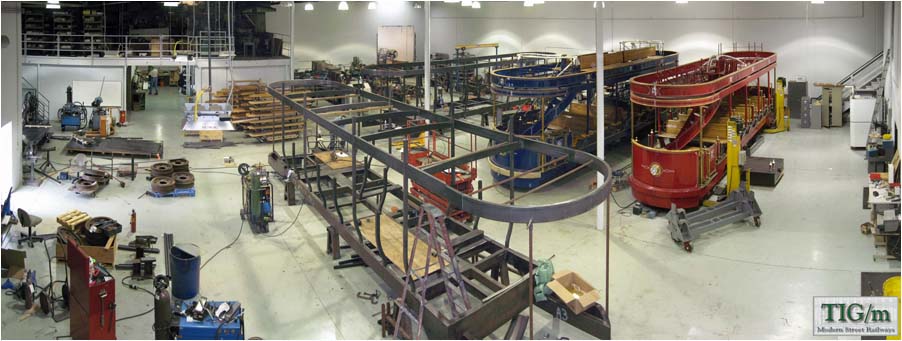
This page is a work in progress.
SOURCES Allen Morrison. Battery Power. Webpage charting the history and development of the battery power used on streetcars 100 years ago. 'Hydrail – The Green Transport Solution We've All Been Waiting For?' in railway-technology.com, 21 June 2011. Pioneer article about the new technology. 'kearthfan101'. The Grove Trolley. YouTube video of the battery-powered streetcar line in Los Angeles. Nice HD image quality. 7 minutes 21 seconds. Arubus, the local bus company which operates the streetcar, solicited applicants for motormen on 1 February 2013. Tramcar - Grand opening ! Oranjestad-Aruba-Caribien. A YouTube video made in March 2013, when the line was still under construction. 5 minutes 43 seconds. 'TIG/m Modern Street Railways Delivering World's Greenest Streetcars to Aruba in Island's Transition to 100% Sustainability' in altenergymag.com, 27 March 2013. Stan Thompson. 'Aruba to Debut 1st Hydrogen Streetcar Fleet' in hydrogencarsnow.com, 1 April 2013. Excellent short description of the Aruba project. Thompson is a prominent promoter of hydrail. 'International Hydrail Conference', June 2013 in Toronto, described at hydrail.org. Information on the meeting and links to many articles. The 'Hydrail' page in Wikipedia supplies good historical material and references to other articles. Aruba has numerous daily newspapers, but most publish only in the Papiamento language (which Google Translate does not translate). For streetcar news the most useful periodicals are Aruba Herald, Diario, and 24ora.com. Aruba | Projects & Economy | Proyectos y Economía. This SkyscraperCity forum is often the best source of information about current developments in Oranjestad.
In addition to the works noted above, the author is indebted to Bradley Read, president of TIG/m, for supplying most of the background information and many of the photographs shown on this page. The author also wishes to thank Thomas Kautzor for the illustrations and map data that he provided in 2014. ––––––––––––––
Also see: Thomas Kautzor, Oranjestad Battery Tram, Aruba, 2014. Trip report, 10 photographs and my index of If you have comments, criticism, suggestions, or good photographs of streetcars in Oranjestad, please e-mail me! This page was first placed online on Copyright © 2013-2113 Allen Morrison |
|---|
